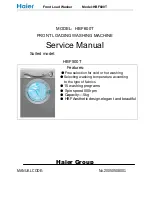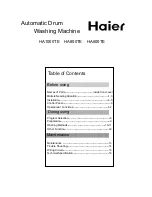
11
Dishwasher Efficiency Tips
Hot water dissolves and activates the dishwashing detergent.
Hot water also dissolves grease on dishes and helps glasses dry
spot-free. For best dishwashing results, water should be 120°F
(49°C) as it enters the dishwasher. Loads may not wash as well if
the water temperature is too low. Water that is too hot can make
some soils harder to remove and cause certain detergent
ingredients not to function. If your water heater is located far from
the dishwasher, it may be necessary to run the hot water at the
faucet closest to the dishwasher to minimize the amount of cold
water in the water line.
To check water temperature
1.
Run hot water at the faucet closest to your dishwasher for at
least 1 minute.
2.
Place a candy or meat thermometer in a glass measuring
cup.
3.
Check the temperature on the thermometer as the water is
running into the cup.
■
To save water, energy and time, do not rinse dishes before
putting them into the dishwasher.
■
Use a low energy, quick, or short cycle whenever possible.
These cycles use less hot water and energy than a normal
cycle.
■
Use a delay feature (on some models) to run your dishwasher
during off-peak hours. Local utilities recommend avoiding
heavy usage of energy at certain times of day.
■
During the summer, run your dishwasher at night. This
reduces daytime heat buildup in the kitchen.
■
Use the energy-saving dry option whenever possible. Allow
longer drying times (overnight) when using these options. Use
a rinse aid to improve drying.
■
Use cycles or options that add extra heat to the wash or rinse
portion of the cycle only when needed.
■
Run your dishwasher with full loads. Run a rinse cycle after
meals until the dishwasher is full.
■
If your home is equipped with a water softener, you may want
to avoid starting the dishwasher during the regeneration of
the softener, as this may contribute to poor wash
performance.
Cycle Selection Charts
Select the wash cycle and options desired. The dishwasher starts
filling once you press a cycle, unless you select a delay wash.
You can select an option as the machine is filling.
Your electronic dishwasher senses the soil level on your dishes.
Soil level determines the length of some cycles, the amount of
heat added to a wash or rinse, and the number of washes and
rinses in a cycle.
Cycle time depends upon the soil on the dishes, and water usage
may be higher for large amounts of soil. If dishes are lightly
soiled, cycle time will be as shown.
After a wash cycle, the dishwasher remembers the options used
and uses the same options in the next wash cycle unless new
options are selected or Cancel/Drain is selected.
A “
●
” shows what steps are in each cycle. Your model may have
some or all of the cycles shown.
Temperatures indicate where extra heat is added.
Water usage is shown in U.S. gallons/liters.
Cycle time includes dry time. An asterisk ( * ) by the cycle time
indicates the cycle time might be longer depending on the
temperature of the water entering the dishwasher. The cooler the
water, the longer the cycle time. If the water is already hot
enough, the cycle time will be as shown.
Pre-
Wash
Rinse
Main
Wash
Rinse
Purge
†
Final
Rinse
Dry
Time
(min)
Water
Usage
(gal/L)
135°F
(57°C)
●
140°F
(60°C)
●
●
140°F
(60°C)
●
●
87*
Light
Soil
8.6-10.8/
32.7-40.9
Pre-
Wash
Rinse
Main
Wash
Rinse
Purge
†
Final
Rinse
Dry
Time
(min)
Water
Usage
(gal/L)
●
●
●
140°F
(60°C)
●
●
72*
Light
Soil
6.9-10.8/
26.1-40.9
Use this cycle for hard-to-
clean, heavily-soiled pots,
pans, casseroles, and
regular tableware.
Use both
detergent
dispenser
sections.
Use this cycle for loads
with heavy food soil.
Use both
detergent
dispenser
sections.
Summary of Contents for GU970
Page 19: ...19 Notes ...






































